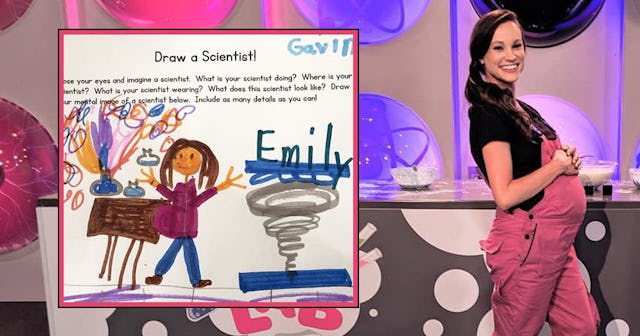Boy's Perfect 'Scientist' Drawing Proves Representation Matters

Emily Calandrelli shared a young fan’s submission to “Draw a Scientist” — and why it’s such a big deal
Prepare to have your heart melted right out of your chest, people. Emily Calandrelli, star and host of Emily’s Wonder Lab on Netflix, posted a young fan’s almost-too-adorable drawing of her. And in the process, she made a heartwarming point about why gender diversity in TV and film matters so very, very much.
In a Facebook post on Monday, Calandrelli showed off the artistic skills of a boy by the name of Gavin. Clearly a fan, he’d chosen her as his subject on a drawing assignment. But it wasn’t just any assignment, as Calandrelli explained.
“The Draw a Scientist Test was first conducted in 1983 in order to study when children learn about stereotypes about scientists,” the MIT-trained engineer began, illuminating some disheartening early statistics. “In the original study of nearly 5,000 kids, only 28 of the girls and no boys drew female scientists. That’s about 0.5% of all the drawings.”
Calandrelli continued, explaining that the percentage has gotten better over the years. However, in the 80+ times the study has been repeated (to over 20,000 students total), boys still draw male scientists 9 times out of 10.
Which brings us to young Gavin and his picture. “A follower sent me this picture on Twitter. Their son, Gavin, was asked to draw a scientist. And this is what he drew,” Calandrelli said, observing that he even captured her pregnant belly in the picture.
“This… makes me feel lots of feelings,” she gushed. “We hear it so often that it starts to lose meaning — but representation matters. It’s incredibly powerful and it changes the way we think. Here’s hoping this Draw a Scientist test continues to reveal a more diverse assumption of what a scientist can look like as the years go on.”
And, honestly, who knew a simple child’s rendering of a scientist could tell us so much? By 2016, 58 percent of girls on average drew female scientists in the study. And while that upward trend is fantastic, why aren’t even more little girls drawing female scientists? Where do we even start with getting more boys like Gavin to draw female scientists?
As of 2015, women made up 48 percent of biological agricultural, and environmental life scientists, according to data from the National Science Foundation. That number is up from just 34 percent in 1993. How do we get it, and children’s impression of females in STEM careers, to trend upward even more?
We show them more real-life examples — like Calandrelli.
“Stereotypes linking science with men might limit girls’ interest in science-related activities and careers,” underscored NSF’s research. In other words, young people (girls and boys) need to see female scientists to help them envision a future filled with women in STEM.
This article was originally published on